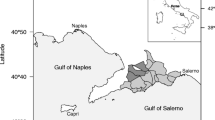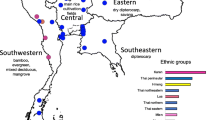Abstract
A previous study provided a general quantitative analysis of 169 collected medicinal plants used by the Q’eqchi’ Maya healers of southern Belize. This paper is focused on a statistical analysis of this ethnobotanical information using the method developed by Moerman (1991). The residual values obtained from the regression analysis of the Q’eqchi’ medicinal plant species versus the species listed in the checklist of the vascular plants of Belize (Balick, Nee, and Atha, 2001) placed the Piperaceae, the Rubiaceae, and the Asteraceae in the first three ranks, and the Poaceae, the Cyperaceae, and the Orchidaceae in the last three ranks. The results were compared with three northern temperate regions (Kashmir, Korea, and North America) and three southern neotropical regions (Chiapas, Ecuador, and Veracruz). The coefficients of correlation between the checklist of vascular plants of Belize and the other six floras showed, as expected, high values for regions with similar climatic type. Thus, high correlations were determined between the tropical vegetation of Belize and those of Chiapas, Ecuador, and Veracruz. The coefficients were lower with the three temperate floras but still quite high. The same analysis was done with the medicinal plants only and led to much lower coefficients, but once again, the higher results were obtained for Chiapas and Veracruz. In this case, the last rank for Ecuador demonstrated that the selection of plants in traditional medicine by the indigenous people is a complex phenomenon which depends not only on the composition of the flora but also on culture-specific factors.
Résumé
Une précédente étude a fourni une analyse quantitative générale de 169 plantes médicinales utilisées par les guérisseurs Maya Q’eqchi’ du sud du Belize. Ce document se concentre sur l’analyse statistique des informations ethnobotaniques selon la méthode développée par Moerman (1991). Les valeurs résiduelles obtenues à partir des analyses de régression des plantes médicinales Q’eqchi’ vis-à-vis des espèces mentionnées dans la liste des plantes vasculaires du Belize (Balick, Nee, et Atha, 2001) ont placé les Piperacées, les Rubiacées et les Asteracées aux trois premières places, et les Poacées, les Cyperacées et les Orchidacées aux trois dernières places. Les résultats ont été comparés avec ceux de trois régions tempérées du nord (Cachemire, Corée, et Amérique du Nord) et de trois régions néotropicales du sud (Chiapas, Équateur, et Veracruz). Les coefficients de corrélation entre les plantes listées dans le manuel des plantes vasculaires du Belize et les six autres flores ont montré comme attendu de hautes valeurs pour les régions possédant un type climatique similaire. Ainsi, une haute corrélation a été démontrée entre la végétation tropicale du Belize et celles du Chiapas, de l’Équateur, et du Veracruz. Les coefficients étaient plus bas avec les trois régions tempérées mais tout de même passablement élevés. La même analyse a été effectuée avec les plantes médicinales et a mené à des coefficients beaucoup plus bas, mais encore une fois, les résultats les plus élevés ont été obtenus pour le Chiapas et le Veracruz. Dans ce cas, la dernière position de l’Équateur a souligné que la sélection des plantes par les indigènes dans la médecine traditionnelle est un phénomène complexe qui dépend non seulement de la composition de la flore mais aussi de facteurs spécifiques à la culture.
Similar content being viewed by others
Literature Cited
Atal, C.K., K.L. Dhar, and J. Singh. 1975. The chemistry of IndianPiper species. Lloydia 38:256–64.
Balick, M.J., M.H. Nee, and D.E. Atha. 2001. Checklist of vascular plants of Belize, with common names and uses. New York Botanical Garden Press, New York.
Chakraberty, C. 1923. An interpretation of ancient Hindu medicine. Neeraj Publishing House, Delhi-110052, India.
Cook, F.E.M. 1995. Economic botany data collection standard. Royal Botanic Gardens Kew, Kent, England.
Cotton, C. M. 1996. Methods in ethnobotanical study. Pages 100–101 in Ethnobotany: Principles and applications. John Wiley and Sons, Chichester, England.
Cronquist, A. 1968. The evolution and classification of flowering plants. Houghton Mifflin, Boston, Massachusetts.
Dasgupta, A., and P.C. Datta. 1980. Medicinal species ofPiper. Pharmacognostic delimitation. Quarterly Journal of Crude Drug Research 18:17–25.
Frohne, D., and U. Jensen. 1998. Systematik des Pflanzenreichs, unter besonderer Beruecksichtigung chemischer nerkmale und pflanzlicher Drogen: 5. Auflage, Wissenschaftliche Verlagsgesellschaft mbH. Stuttgart, Germany.
Joly, A.B. 1977. Botãnica—Introdução à Taxonomia Vegetal. Companhia Editoria Nacional, São Paulo, Brazil.
Leonti, M., F. R. Ramirez, O. Sticher, and M. Heinrich. 2003. Medicinal flora of the Popoluca, Mexico: A botanical systematical perspective. Economic Botany 57(2):218–230.
Meltzer, H.M., and K.E. Malterud. 1997. Can dietary flavonoids influence the development of coronary heart disease? Scandinavian Journal of Nutrition 41(2):50–57.
Moerman, D.E. 1991. The medical flora of native North American: An analysis. Journal of Ethnopharmacology 31:1–42.
—, R.W. Pemberton, D. Kiefer, and B. Berlin. 1999. A comparative analysis of five medicinal floras. Journal of Ethnobiology 19:49–67.
Runyon, R. P., and A. Haber. 1984. Fundamentals of behavioral statistics. 5th ed. Addison-Wesley Publishing Company, Don Mills, Ontario, Canada.
Saleh, N. A.M., C. Nozzolillo, and I. Altosaar. 1988. Flavonoid variations inAvena species. Biochemical Systematics and Ecology 16(7/8):597–599.
Schulz, M., and G. Weissenböck. 1987. Partial purification and characterization of a luteolin-triglucuronide-specific β-glucuronidase from rye primary leaves (Secale cereale). Phytochemistery 26(4):933–937.
Scott, I. M. 2004. The efficacy and mode of action of aPiper (Piperaceae) botanical insecticide for control of insect pests of the home and garden. Ph.D. Thesis, University of Ottawa, Ontario, Canada.
Simons, R.C., and C.C. Hughes, eds. 1986 The culture-bound syndromes: Folk illnesses of psychiatric and anthropological interest. Reidel Publishing Company, Boston, Massachusetts.
SYSTAT. 1999. Version 9.0. Systat Software, Inc., Richmond, California.
Thorne, R. F. 2000. The classification and geography of the flowering plants: Dicotyledons of the class Angiospermae (Subclasses Magnoliidae, Ranunculidae, Caryophyllidae, Dilleniidae, Rosidae, Asteridae, and Lamiidae). Botanical Review 66 (4):441–647.
Treyvaud Amiguet, V., J. T. Arnason, P. Maquin, V. Cal, P. Sanchez Vindas, and L. Poveda. 2005. A consensus ethnobotany of the Q’eqchi’ Maya of southern Belize. Economic Botany 59(l):29–42.
Author information
Authors and Affiliations
Rights and permissions
About this article
Cite this article
Amiguet, V.T., Arnason, J.T., Maquin, P. et al. A regression analysis of q’eqchi’ Maya medicinal plants from southern Belize. Econ Bot 60, 24–38 (2006). https://doi.org/10.1663/0013-0001(2006)60[24:ARAOQM]2.0.CO;2
Received:
Accepted:
Issue Date:
DOI: https://doi.org/10.1663/0013-0001(2006)60[24:ARAOQM]2.0.CO;2




